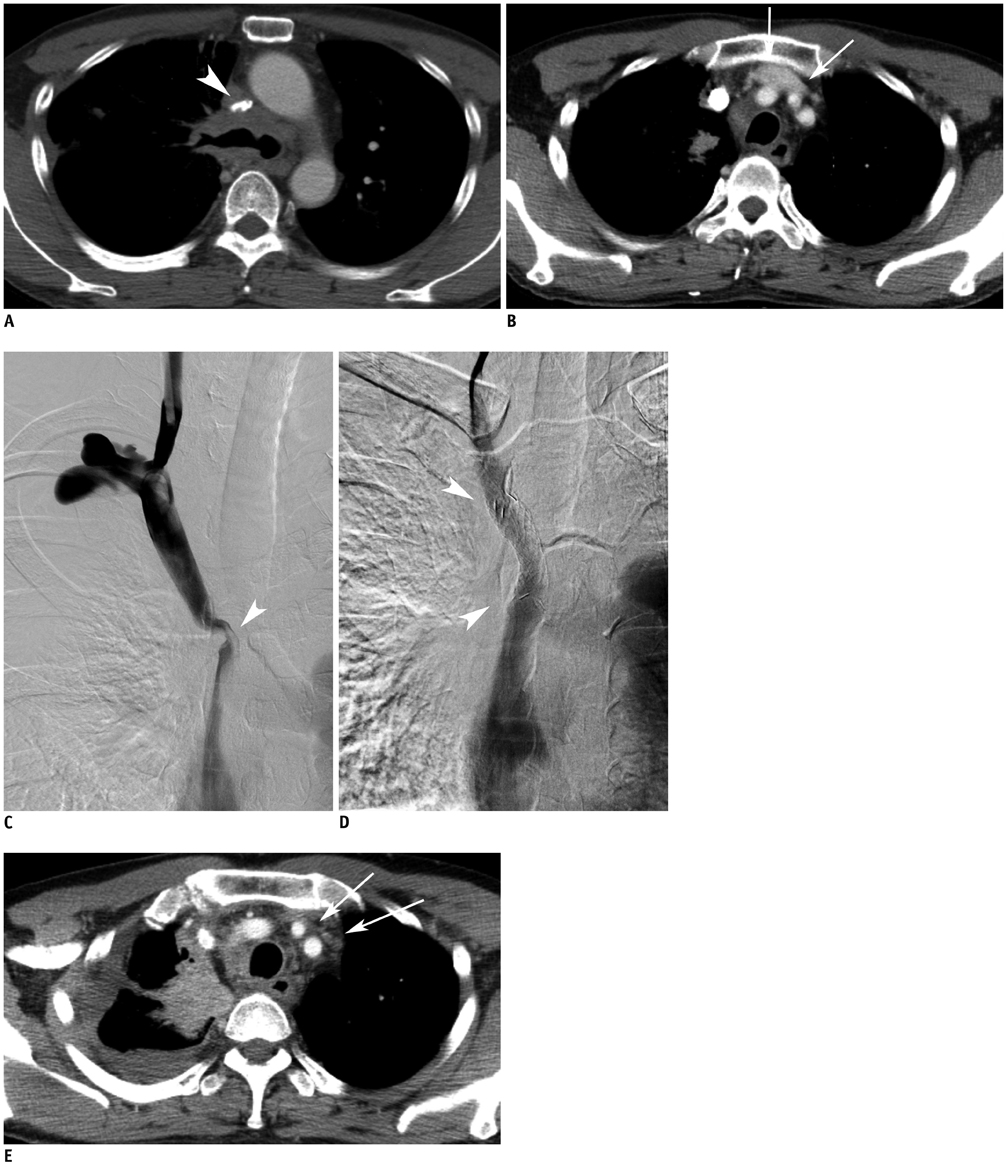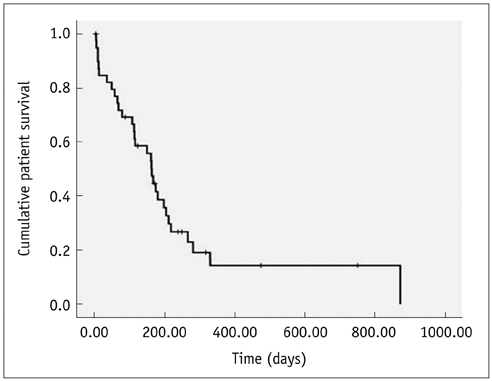Korean J Radiol.
2014 Feb;15(1):87-94. 10.3348/kjr.2014.15.1.87.
Covered Stent Placement for the Treatment of Malignant Superior Vena Cava Syndrome: Is Unilateral Covered Stenting Safe and Effective?
- Affiliations
-
- 1Department of Radiology and Research Institute of Radiology, University of Ulsan College of Medicine, Asan Medical Center, Seoul 138-736, Korea. radgwon@amc.seoul.kr
- KMID: 1711482
- DOI: http://doi.org/10.3348/kjr.2014.15.1.87
Abstract
OBJECTIVE
To evaluate the safety and efficacy of unilateral covered stent placement in patients with malignant superior vena cava (SVC) syndrome.
MATERIALS AND METHODS
Between October 2008 and November 2012, expanded polytetrafluoroethylene-covered stent placement for malignant SVC syndrome was performed in 40 consecutive patients (35 men and five women; mean age, 61.4 years; range, 35-81 years). All covered stents were unilaterally placed within the SVC or across the venous confluence when needed to relieve venous obstruction and prevent tumor overgrowth, regardless of patency of contralateral brachiocephalic veins.
RESULTS
Stent placement was technically successful in all patients. There were no major complications. Of the 37 patients symptomatic prior to stent placement, 34 (92%) experienced complete symptomatic relief 1-8 days after stent placement. Of the 29 patients who underwent covered stent placement across the venous confluence, nine patients had patent contralateral brachiocephalic veins prior to stent placement. However, no sign of SVC obstruction or contralateral upper extremity venous thrombosis was observed during the follow-up period. Kaplan-Meier analysis revealed median patient survival of 163 days. Stent occlusion occurred in four (10%) of 40 patents. Cumulative stent patency rates at 1, 3, 6, and 12 months were 95%, 92%, 86%, and 86%, respectively.
CONCLUSION
Unilateral covered stent placement appears to be a safe and effective method for treating malignant SVC syndrome, despite the location of SVC occlusion.
MeSH Terms
Figure
Reference
-
1. Reechaipichitkul W, Thongpaen S. Etiology and outcome of superior vena cava (SVC) obstruction in adults. Southeast Asian J Trop Med Public Health. 2004; 35:453–457.2. Rowell NP, Gleeson FV. Steroids, radiotherapy, chemotherapy and stents for superior vena caval obstruction in carcinoma of the bronchus: a systematic review. Clin Oncol (R Coll Radiol). 2002; 14:338–351.3. Picquet J, Blin V, Dussaussoy C, Jousset Y, Papon X, Enon B. Surgical reconstruction of the superior vena cava system: indications and results. Surgery. 2009; 145:93–99.4. Dyet JF, Nicholson AA, Cook AM. The use of the Wallstent endovascular prosthesis in the treatment of malignant obstruction of the superior vena cava. Clin Radiol. 1993; 48:381–385.5. Urban T, Lebeau B, Chastang C, Leclerc P, Botto MJ, Sauvaget J. Superior vena cava syndrome in small-cell lung cancer. Arch Intern Med. 1993; 153:384–387.6. Smayra T, Otal P, Chabbert V, Chemla P, Romero M, Joffre F, et al. Long-term results of endovascular stent placement in the superior caval venous system. Cardiovasc Intervent Radiol. 2001; 24:388–394.7. Azizzadeh A, Pham MT, Estrera AL, Coogan SM, Safi HJ. Endovascular repair of an iatrogenic superior vena caval injury: a case report. J Vasc Surg. 2007; 46:569–571.8. Chin DH, Petersen BD, Timmermans H, Rösch J. Stent-graft in the management of superior vena cava syndrome. Cardiovasc Intervent Radiol. 1996; 19:302–304.9. Gill K, Ettles DF, Nicholson AA. Recurrent superior vena caval obstruction due to invasion by malignant thymoma: treatment using a stent-graft. Br J Radiol. 2000; 73:1015–1017.10. Mansour M, Altenburg A, Haage P. Successful emergency stent implantation for superior vena cava perforation during malignant stenosis venoplasty. Cardiovasc Intervent Radiol. 2009; 32:1312–1316.11. Gwon DI, Paik SH. Successful treatment of malignant superior vena cava syndrome using a stent-graft. Korean J Radiol. 2012; 13:227–231.12. Sacks D, McClenny TE, Cardella JF, Lewis CA. Society of Interventional Radiology clinical practice guidelines. J Vasc Interv Radiol. 2003; 14:S199–S202.13. Bierdrager E, Lampmann LE, Lohle PN, Schoemaker CM, Schijen JH, Palmen FM, et al. Endovascular stenting in neoplastic superior vena cava syndrome prior to chemotherapy or radiotherapy. Neth J Med. 2005; 63:20–23.14. Gross CM, Krämer J, Waigand J, Uhlich F, Schröder G, Thalhammer C, et al. Stent implantation in patients with superior vena cava syndrome. AJR Am J Roentgenol. 1997; 169:429–432.15. Nagata T, Makutani S, Uchida H, Kichikawa K, Maeda M, Yoshioka T, et al. Follow-up results of 71 patients undergoing metallic stent placement for the treatment of a malignant obstruction of the superior vena cava. Cardiovasc Intervent Radiol. 2007; 30:959–967.16. Lanciego C, Pangua C, Chacón JI, Velasco J, Boy RC, Viana A, et al. Endovascular stenting as the first step in the overall management of malignant superior vena cava syndrome. AJR Am J Roentgenol. 2009; 193:549–558.17. Nicholson AA, Ettles DF, Arnold A, Greenstone M, Dyet JF. Treatment of malignant superior vena cava obstruction: metal stents or radiation therapy. J Vasc Interv Radiol. 1997; 8:781–788.18. Watkinson AF, Yeow TN, Fraser C. Endovascular stenting to treat obstruction of the superior vena cava. BMJ. 2008; 336:1434–1437.19. Nguyen NP, Borok TL, Welsh J, Vinh-Hung V. Safety and effectiveness of vascular endoprosthesis for malignant superior vena cava syndrome. Thorax. 2009; 64:174–178.20. Uberoi R. Quality assurance guidelines for superior vena cava stenting in malignant disease. Cardiovasc Intervent Radiol. 2006; 29:319–322.21. Ganeshan A, Hon LQ, Warakaulle DR, Morgan R, Uberoi R. Superior vena caval stenting for SVC obstruction: current status. Eur J Radiol. 2009; 71:343–349.22. Kee ST, Kinoshita L, Razavi MK, Nyman UR, Semba CP, Dake MD. Superior vena cava syndrome: treatment with catheter-directed thrombolysis and endovascular stent placement. Radiology. 1998; 206:187–193.23. Fagedet D, Thony F, Timsit JF, Rodiere M, Monnin-Bares V, Ferretti GR, et al. Endovascular treatment of malignant superior vena cava syndrome: results and predictive factors of clinical efficacy. Cardiovasc Intervent Radiol. 2013; 36:140–149.24. Dinkel HP, Mettke B, Schmid F, Baumgartner I, Triller J, Do DD. Endovascular treatment of malignant superior vena cava syndrome: is bilateral wallstent placement superior to unilateral placement? J Endovasc Ther. 2003; 10:788–797.25. Urruticoechea A, Mesía R, Domínguez J, Falo C, Escalante E, Montes A, et al. Treatment of malignant superior vena cava syndrome by endovascular stent insertion. Experience on 52 patients with lung cancer. Lung Cancer. 2004; 43:209–214.26. Wan JF, Bezjak A. Superior vena cava syndrome. Hematol Oncol Clin North Am. 2010; 24:501–513.27. Furui S, Sawada S, Kuramoto K, Inoue Y, Irie T, Makita K, et al. Gianturco stent placement in malignant caval obstruction: analysis of factors for predicting the outcome. Radiology. 1995; 195:147–152.28. Gwon DI, Ko GY, Kim JH, Shin JH, Yoon HK, Sung KB. Malignant superior vena cava syndrome: a comparative cohort study of treatment with covered stents versus uncovered stents. Radiology. 2013; 266:979–987.
- Full Text Links
- Actions
-
Cited
- CITED
-
- Close
- Share
- Similar articles
-
- Successful Treatment of Malignant Superior Vena Cava Syndrome Using a Stent-Graft
- A Case of Superior Vena Cava Syndrome
- Superior Vena Cava Thrombosis Treated Successfully by Percutaneous Insertion of Metallic Stent in a Patient with Behcet's Disease
- lilac Vein Thrombosis: A Case Report of Treatment with Inferior Vena Cava Filter, Urokinase and Vascular Stent
- Intractable in Stent Thrombosis in Malignant Superior Vena Cava Syndrome




